
Table of Contents
As the Mid-Autumn Festival approaches, traditional Cantonese mooncakes make their annual appearance. Artfully molded pastries filled with a sweet nut or bean based filling, these beautiful pastries are a must-have for gifting to friends and family and creating a festive mood. These days you can fairly easily find mooncakes in Chinatown and at large Asian markets. But nothing beats the homemade type, which tastes way more fragrant and is not super sweet.
The most common mooncake fillings are lotus seed paste filling and red bean paste filling. But in this post, I want to share my favorite mooncake flavor – black sesame filling. Compared to the other fillings, this one is nuttier, softer and more fragrant, without the typical sticky texture the other fillings have. I like to pair it with salted duck yolks, adding a savory note and balancing out the sweetness.
What are traditional mooncakes?
- Dough made with golden syrup (inverted sugar syrup), a little kansui (alkaline water), oil, and cake flour. These ingredients yield a tender but shape-holding pastry.
- Filling with a high oil content (often lard traditionally; butter or vegetable oil in modern days), a sweet bean or seed paste, frequently paired with salted duck egg yolk. The fat not only enriches the flavor but also enables the mooncake to “rest” into its ideal texture.
- Thin skin enveloping a generous filling, often with beautiful mold-pressed designs. The balance between dough and filling is key.
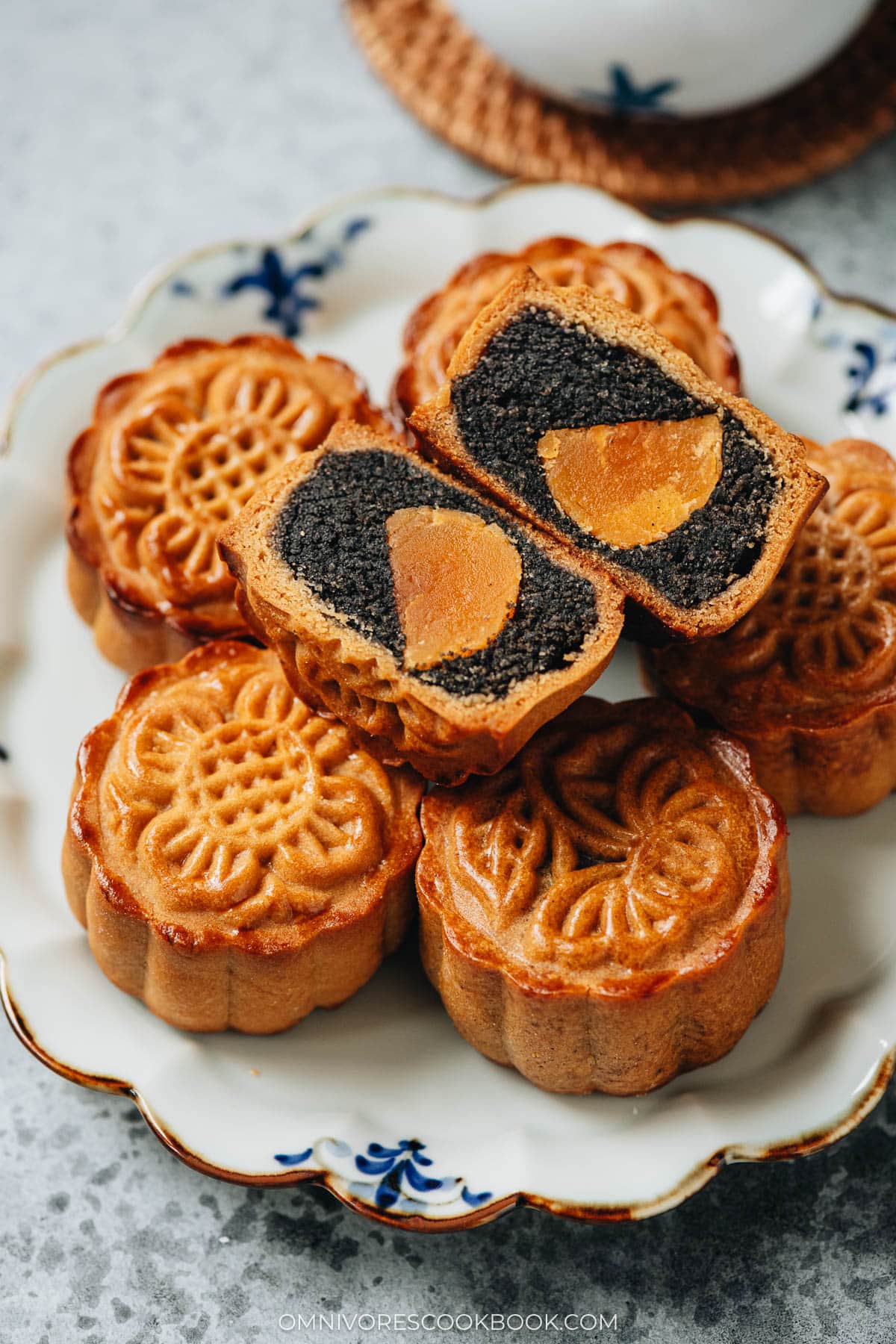
Special tools you need
To make the intricate mooncake patterns, you will need to purchase mooncake molds. There are traditional wooden molds available, but most home cooks prefer the plastic type because they’re easier to use.
Mooncake molds usually come in 50-gram and 100-gram sizes, with the number indicating the weight of the mooncake made by it. Most homemade recipes (including this one) work better with the 50-gram mold. It makes mini sized mooncakes that are very cute in appearance and easier to serve and gift. Larger mooncakes are often cut into quarters or halves when served, because they’re quite rich and sweet.
You can easily find all kinds of mooncake molds on Amazon. Choose your favorite patterns, but make sure you get the hand-press type mold.
Mooncake dough ingredients
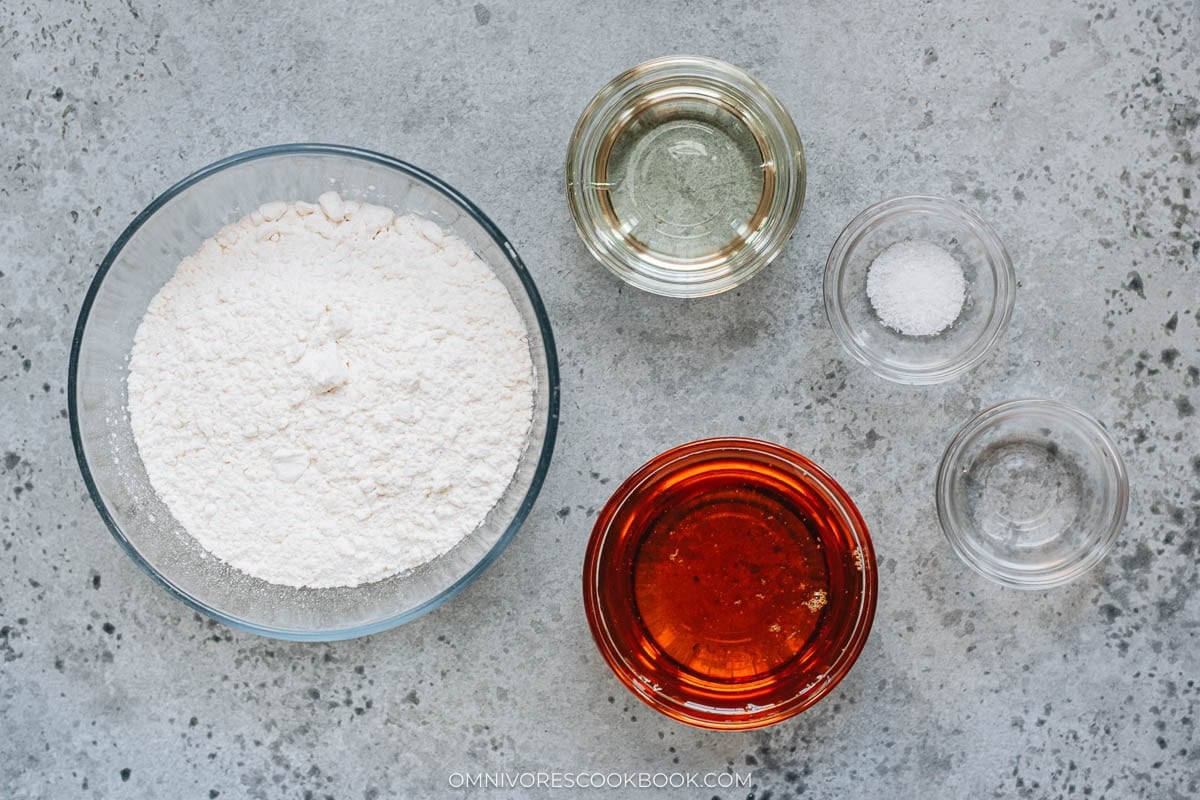
Traditional mooncakes do not require a lot of ingredients, but you will need to purchase a few specialty ingredients. Fortunately, it is getting easier and easier to purchase these specialty ingredients online. And I’ve also included detailed posts on how to make the specialty ingredients at home.
Golden syrup
Also called inverted sugar. It attracts and retains moisture. This keeps the pastry tender, prevents crystallization, and helps the crust stay soft after the “resting” period (回油, hui you). It has a deep, caramel-like taste. It also gives the dough flexibility and just the right stickiness, so it molds cleanly and holds the intricate mooncake patterns after pressing.
In short, golden syrup provides flavor, color, moisture, and workability. They are all crucial for achieving authentic mooncakes.
You can purchase golden syrup on Amazon.
If golden syrup is not available where you live, you can also use my homemade golden syrup recipe to make it at home.
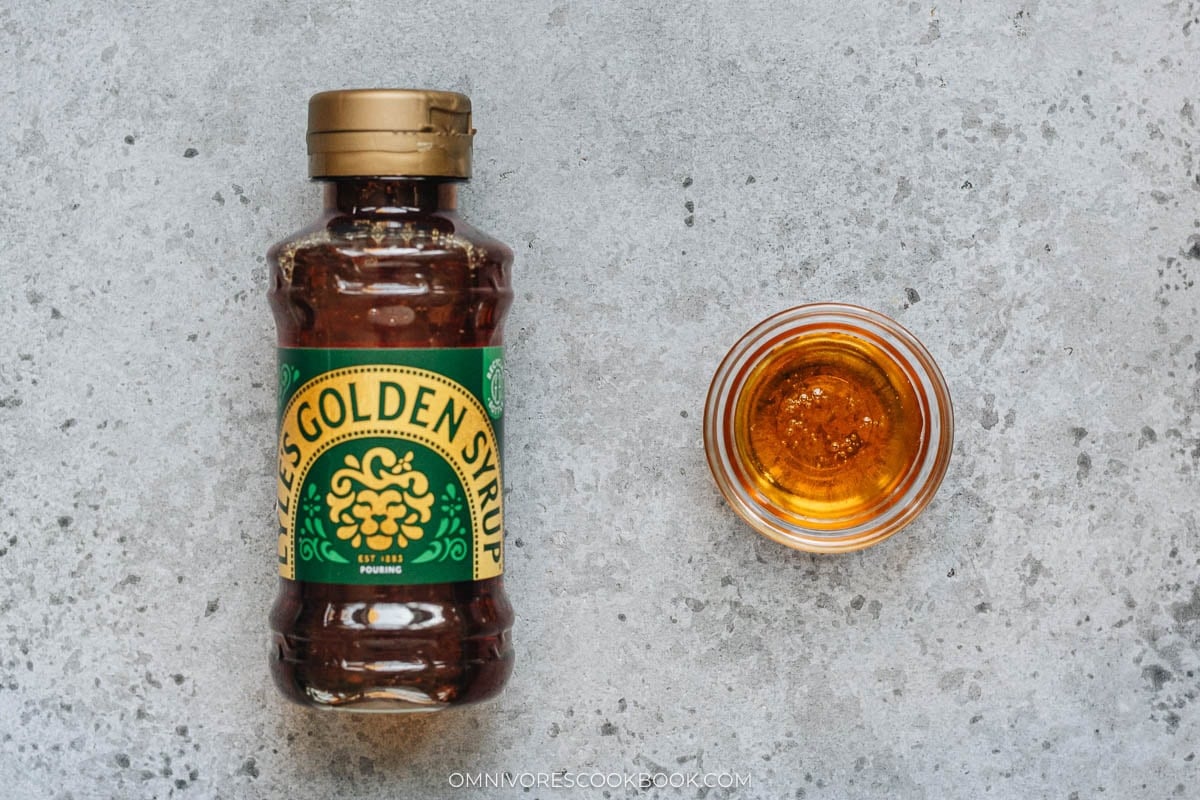
Kasui
Kansui (alkaline water, lye water, 枧水) works hand-in-hand with golden syrup in mooncake dough. Since golden syrup is slightly acidic, a small amount of kansui neutralizes that acidity, preventing the dough from being too sticky or weak. It also strengthens the gluten bonds just enough so the dough is pliable but not tough. This allows the dough to be very thin without cracking. Lastly, it helps the pastry absorb oil from the filling more evenly during the resting period, giving the skin that glossy, tender finish.
You can usually find kansui in Chinese markets, some large Asian markets such as Ranch 99, and at Chinatown shops. You can find it on Amazon as well.
If not available, you can use my homemade kansui guide to make it using baking soda.
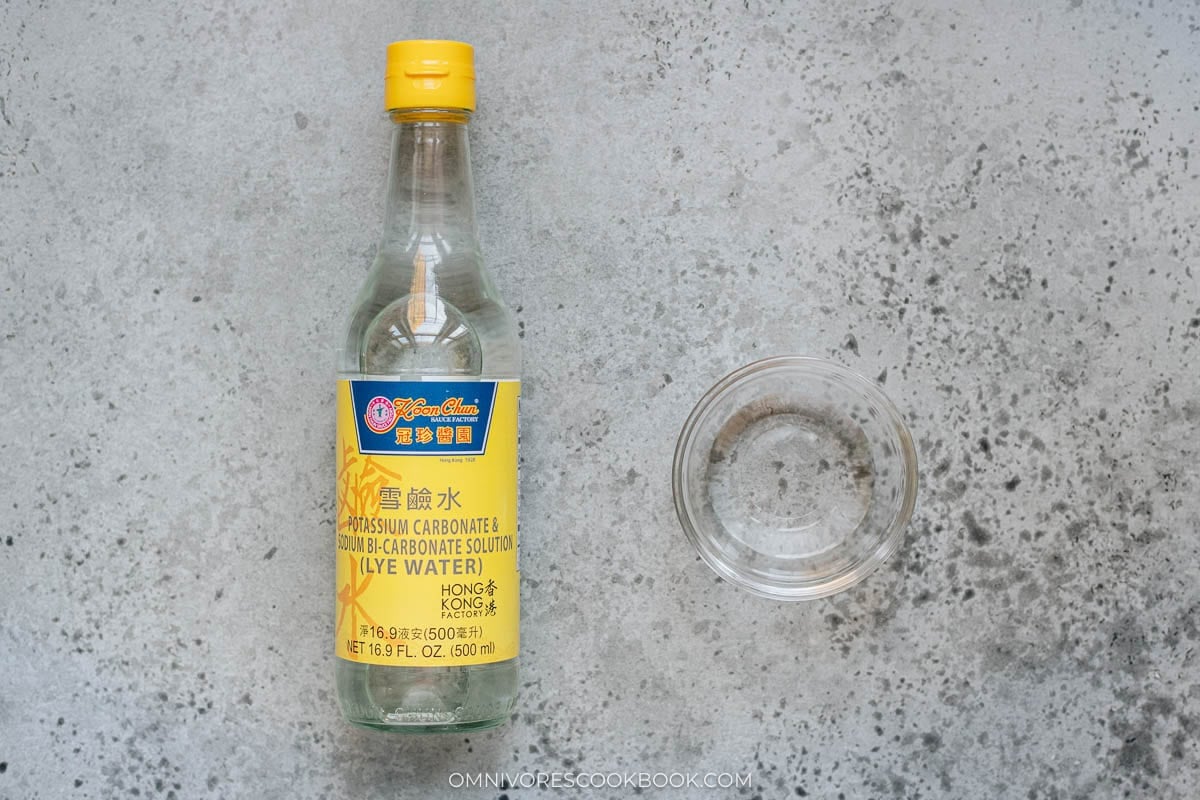
Cake flour
Cake flour is another key ingredient to create the tender mooncake dough texture.
Mooncakes in China are usually made with all-purpose flour. Compared to the fortified flour in the US, Chinese flour is milled differently and finer in texture. It is not fortified and has a lower gluten content (about 2%). In the US, the closest type is cake flour. It is essential to create a tender and pliable dough.
If you’re close to a Chinese market or large Asian markets, another great alternative is to buy Chinese all-purpose flour or Korean all-purpose flour. Both yield a slightly better texture than US-made cake flour.
That being said, it is possible to use all-purpose flour. Your dough might come out a little tougher, but I’ve included tips on how to work with tougher dough in the recipe below.
Mooncake filling ingredients
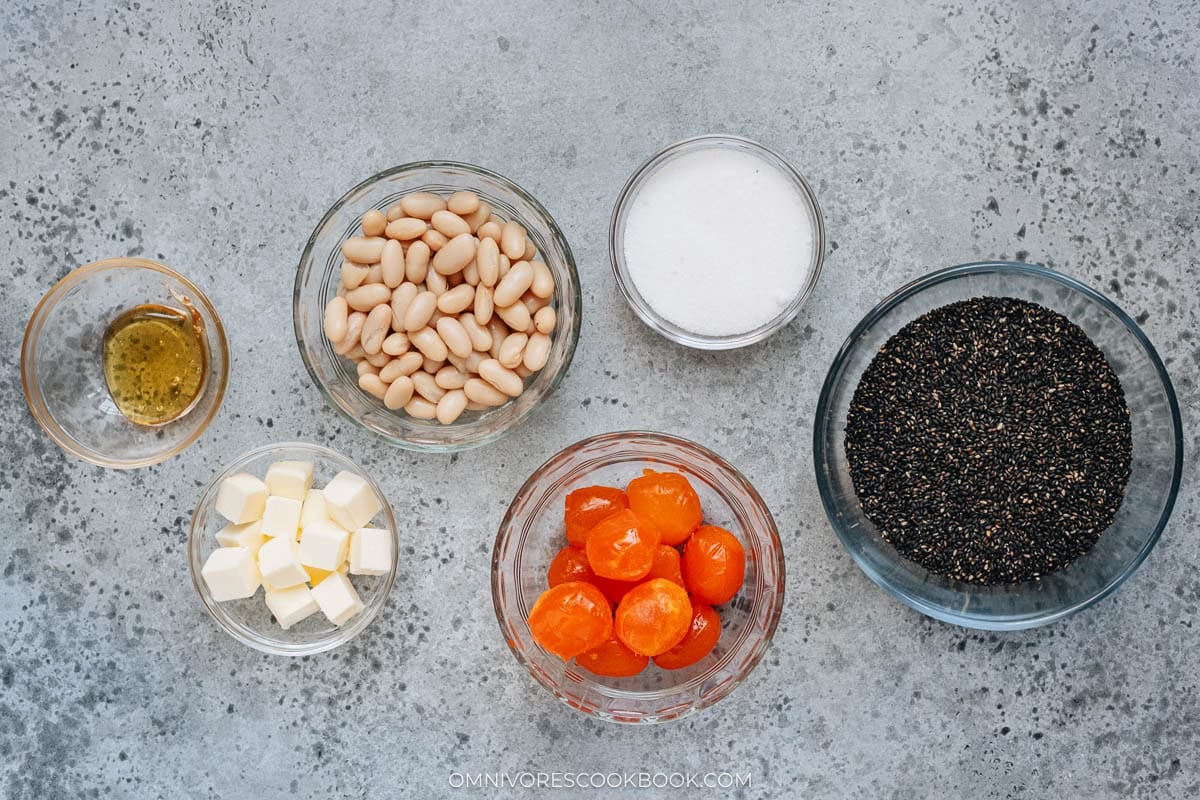
Black sesame paste is my favorite mooncake filling and I spent a lot of time developing the best texture. Here are some of the key ingredients besides black sesame seeds.
White beans
Most black sesame mooncake filling is not made of 100% black sesame seeds. Because 1) black sesame seeds are expensive. 2) Black sesame seeds alone do not yield the signature smooth texture that every mooncake filling should have.
In this recipe, I used white beans due to their very mild flavor and tender texture. They work as a binder so the filling is shapable. Due to their mild taste, the black sesame seeds blend right in and the filling won’t taste beany at all.
Butter
Traditionally, mooncake makers preferred to use lard in their filling, because it solidifies at room temperature and it makes the mooncakes easy to shape. In modern days, most people prefer to use vegetable oil.
In my recipe, I chose butter over vegetable oil because: 1) It adds a richer aroma to the filling and 2) butter solidifies in the fridge, making the filling easier to shape.
Maltose
Maltose (麦芽糖) is often used in traditional mooncake fillings. It is a very sticky and thick syrup at room temperature. It binds the paste together, making it smooth, glossy, and cohesive rather than crumbly. You can find maltose in Chinese markets and on Amazon.
That being said, I’ve made black sesame filling without maltose and the result was quite nice. If you do not have this ingredient, simply skip it and your mooncakes will turn out nicely.
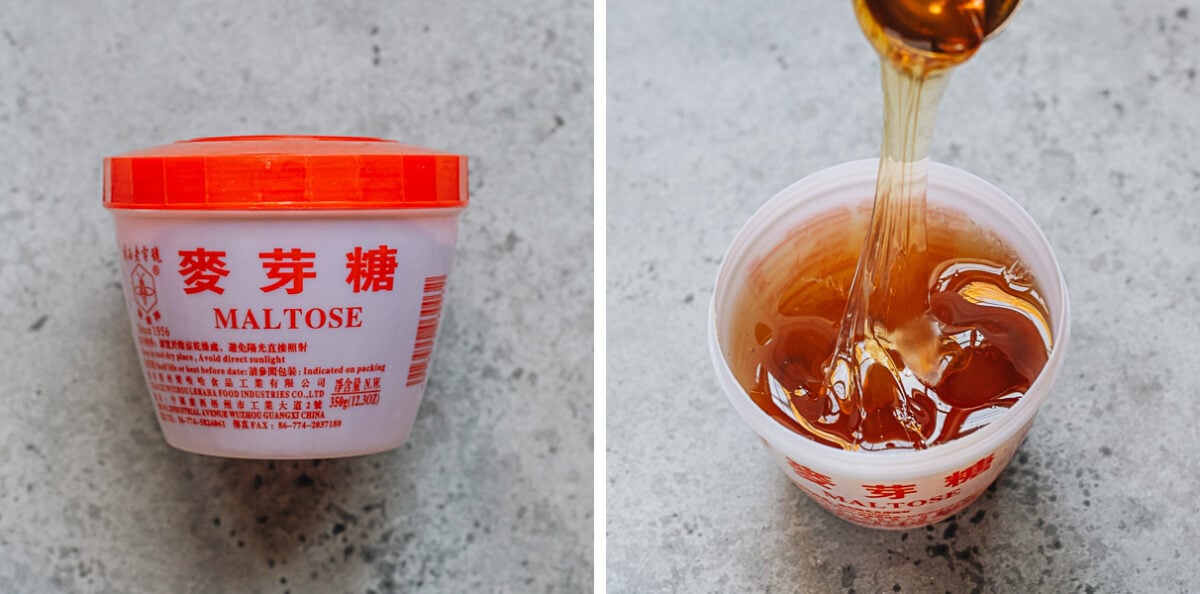
Salted duck yolk
Salted duck yolk is a classic element in Cantonese mooncakes and it’s my favorite thing about them. The rich, salty yolk balances the sweet, dense filling, making the mooncakes more complex and preventing them from tasting overly sweet. Salted yolks have a sandy, crumbly texture that contrasts beautifully with the smooth filling.
You can usually find frozen cooked duck egg yolks at Chinese markets. It’s also possible to purchase whole salted duck eggs and use only the yolks, but the packaged frozen type is much more convenient.
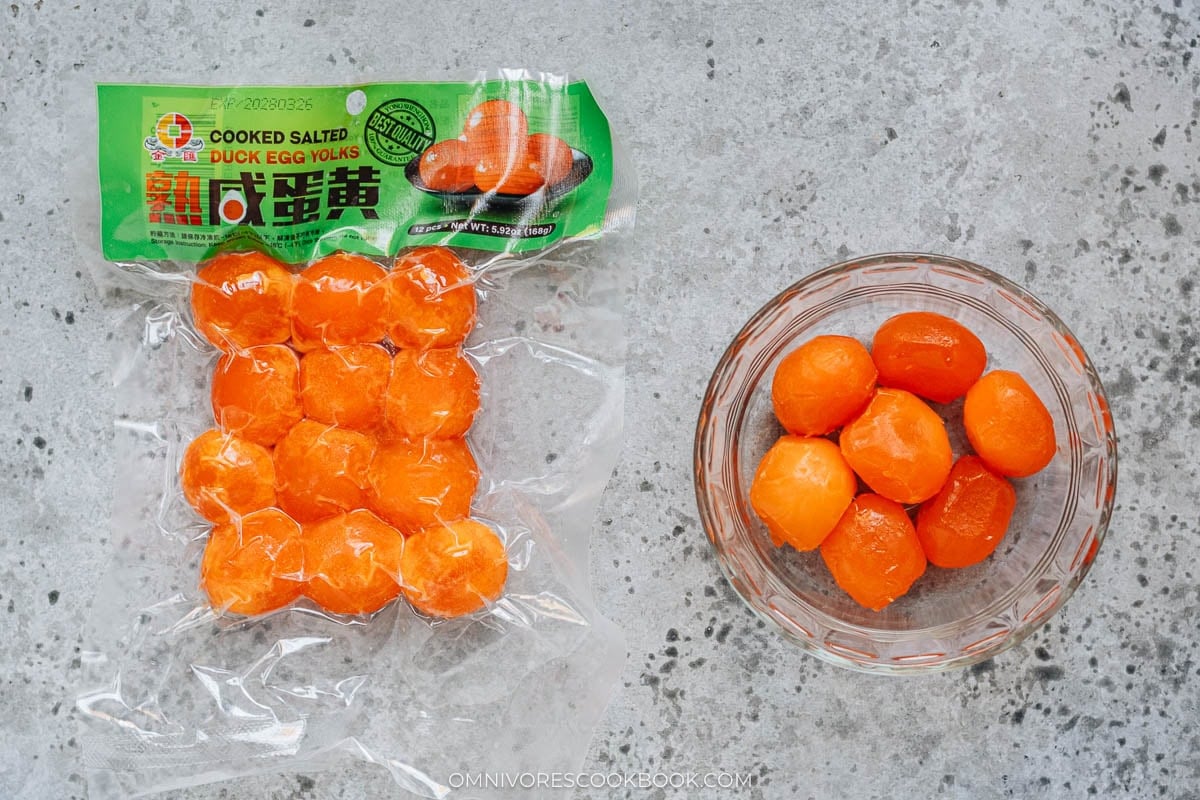
On the other hand, if you do not like this ingredient, it’s totally OK to skip it as well. In this case, you will need to make extra black sesame filling (see more details in the recipe below).
Why cut the duck egg yolk in half?
This recipe makes 50-gram mooncakes, which require 30 grams of filling. A whole duck egg yolk usually weighs around 14g and is very large in size. It’s very difficult to wrap a whole yolk into a small mooncake. It’s only possible to use whole yolks if you happen to find yolks that are smaller than 10g each, which are rare. That’s why I prefer to halve the yolks to make the shaping process easier.
Other filling alternatives
If you do not want to make black sesame paste filling, you have a few other options.
You can use store-bought mooncake filling. And the most common types are red bean paste and lotus seed paste. When shopping for red bean paste, make sure to check the ingredients – it should contain oil and maltose. This is the correct type for making mooncakes. Red bean paste made with water but not oil is not suitable for mooncakes.
If you have extra time, consider making these fillings at home. I have recipes for lotus seed paste filling and red bean paste filling. Compared to the store bought type, homemade paste has a richer taste and is more fragrant. You can also adjust the sweetness level to suit your own taste.
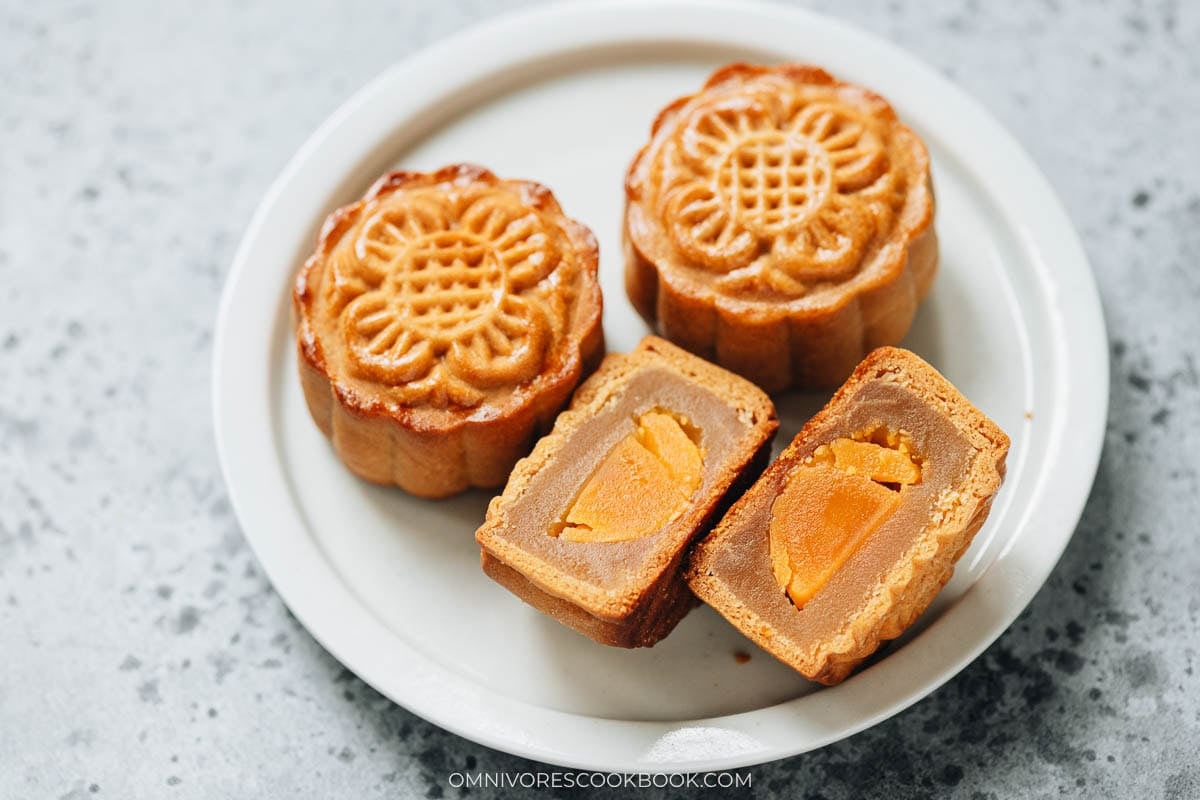
How to make
Traditional mooncakes require some time and effort to make. But if you’re organized and not rushed, it’s a very relaxing and enjoyable process. Make sure you have half a day and put on your favorite music or TV show!
Prepare the mooncake filling
My homemade black sesame filling has a fluffier and softer texture than the store bought type. But it requires a little more chill time so it’s easier to work with.
- Blend the black sesame seeds until they start to seep oil. This ensures a smooth filling without tasting gritty. I like to use toasted black sesame seeds because they’re easier to work with and yield a better result. If using raw sesame seeds, you have to roast them until they are cooked through beforehand.
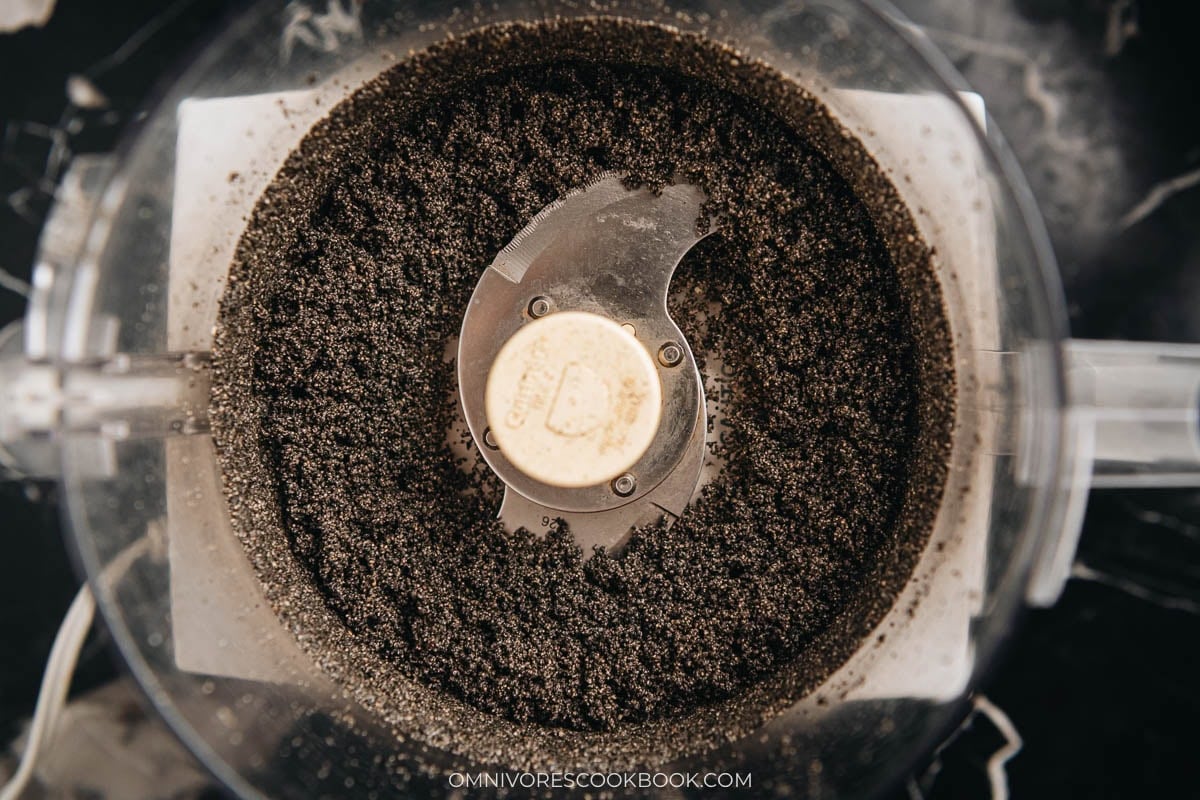
- Add the sugar and white beans and blend until it forms a paste. The paste is quite thick and your food processor might stop before everything is fully blended. You can add a little water in this case. If you add water, you will need to spend more time cooking off the water later, so the paste is dry enough to shape.
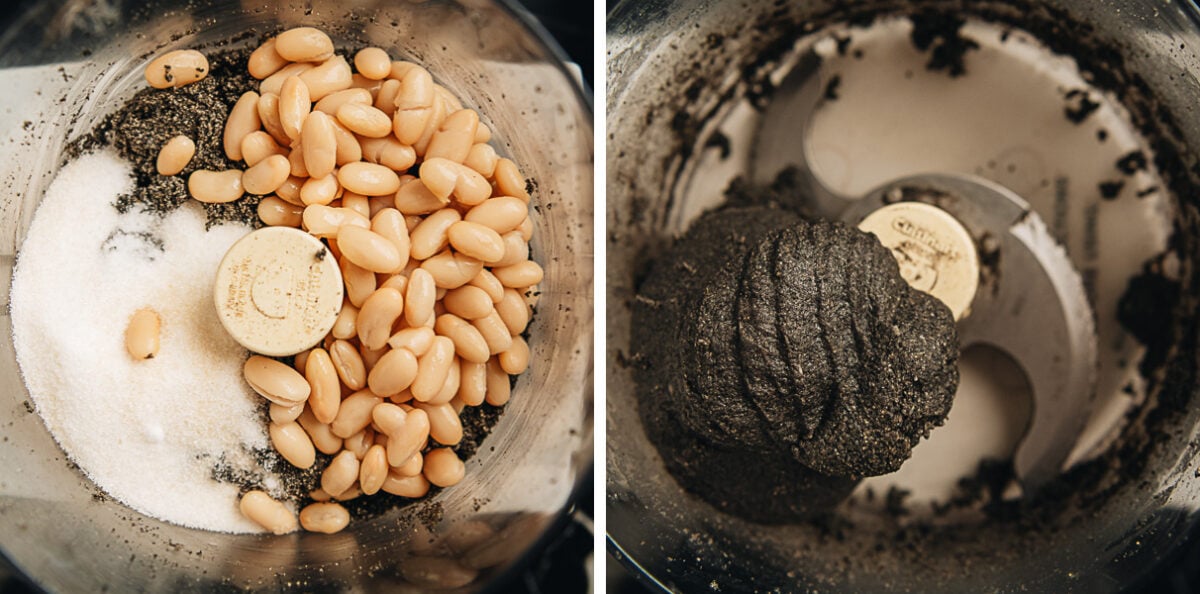
- Melt the butter and cook the butter into the paste. Then fold in the maltose, if using. The paste should look quite dry once cooked. And it will solidify further once cooled off. It is important to cook the paste enough until it’s quite dry. Otherwise the mooncakes will be very difficult to shape.

Prepare the mooncake dough
Mooncake dough is quite easy to put together. The most important thing is to measure out the ingredients in grams, so the dough has the correct texture.
- Mix golden syrup, kansui, oil and salt together. Stir them very well until the mixture emulsifies. This step is crucial. You want the golden syrup and kansui to react, so the dough forms properly.
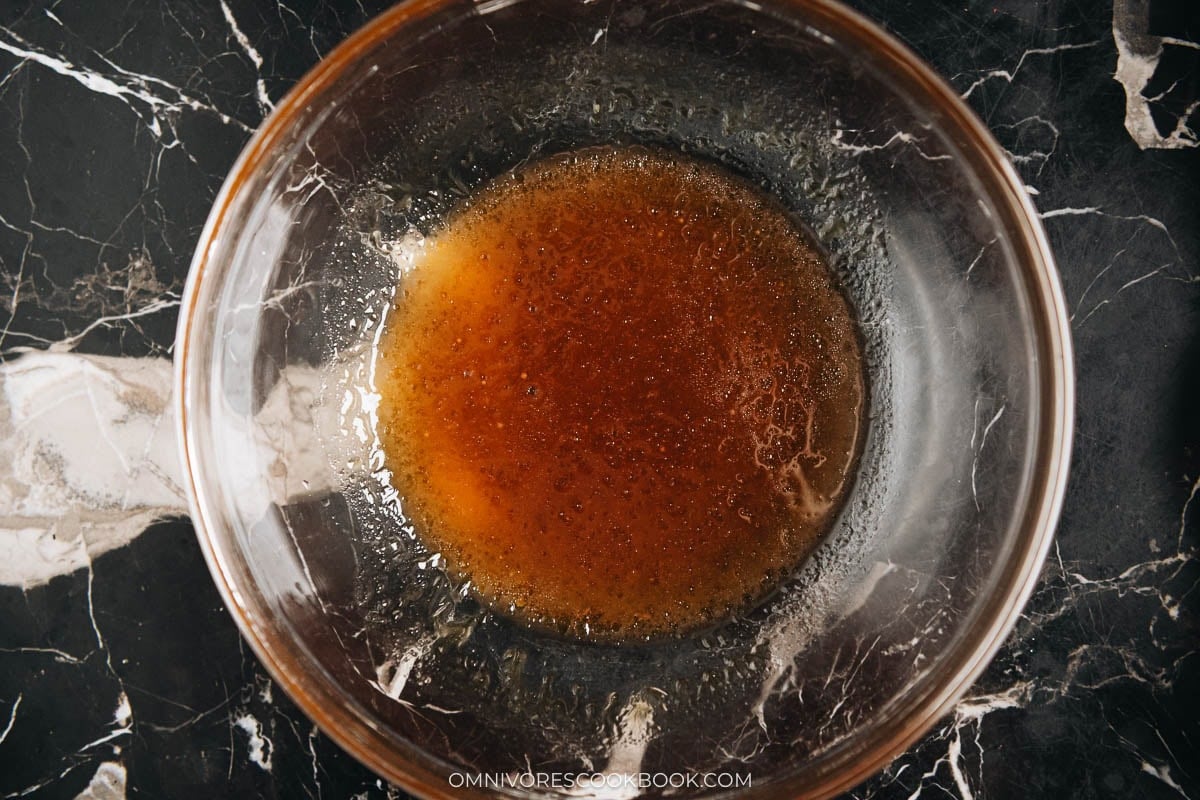
- Add the flour and shape the dough. Always using a scraping and folding motion, to avoid development of too much gluten. The dough will be quite soft and sticky, but should still hold its own shape.
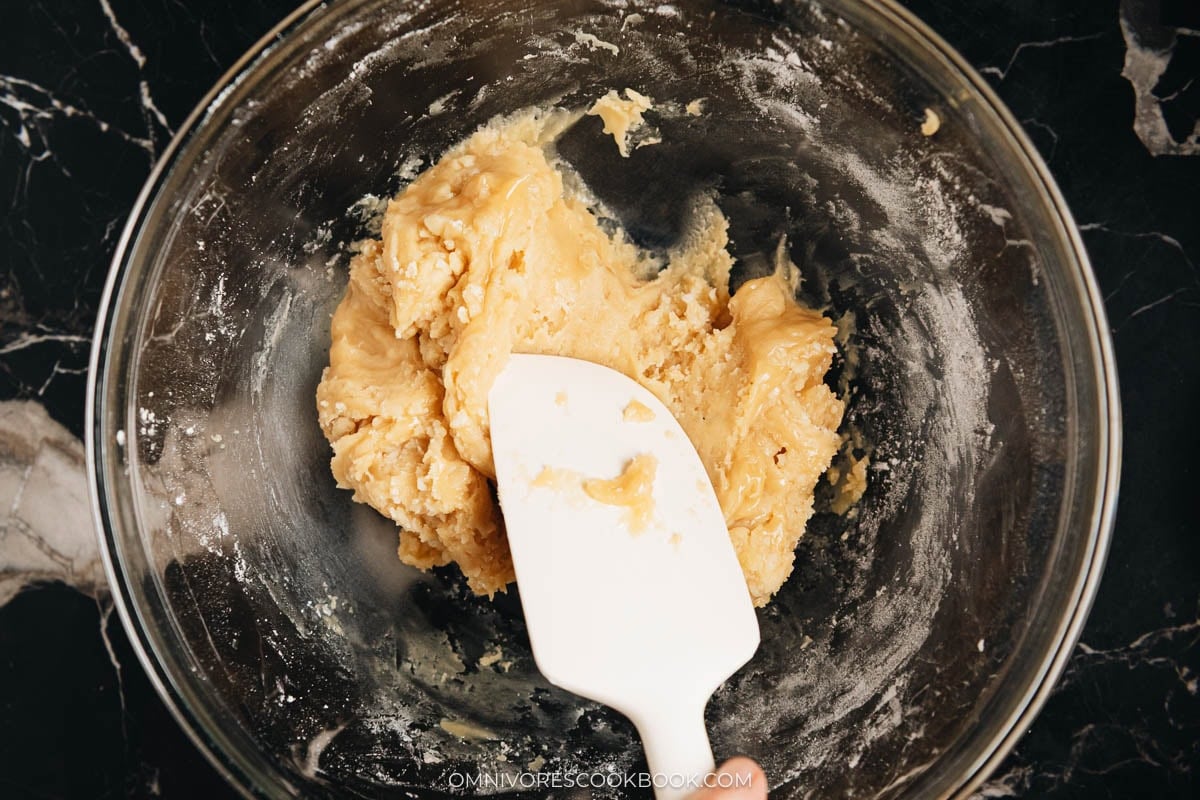
- Once the ingredients are fully incorporated, shape and gently work the dough with your hands until it forms a ball. Rest the dough for at least two hours, up to half a day. Do not refrigerate the dough.
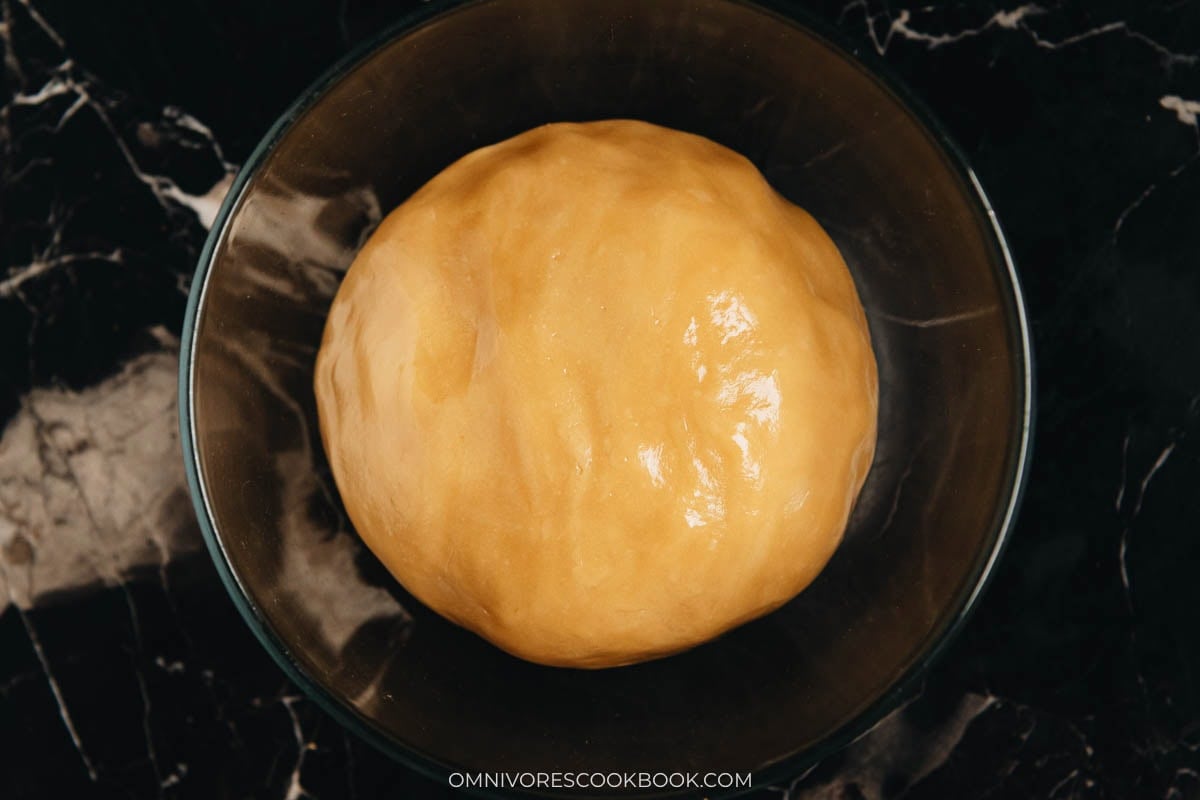
Prepare the mooncake filling
- Measure out 30 grams of filling using a scale. It should be 30 grams in total if using both salted duck egg and black sesame paste. If you do not plan to use duck egg yolks, you should measure 30 grams of black sesame paste.
- Shape each filling into a ball. If using the egg yolk, wrap the yolk inside of the sesame paste then shape it into a ball.
- Store the shaped filling in the freezer for 30 minutes while you prepare the mooncake dough. This process further solidifies the filling, making it much easier to work with during shaping.

To assemble the mooncakes
- Once the mooncake dough is rested, divide the dough into 20-gram pieces and shape them into balls.
- To wrap a mooncake, press the dough piece in your palm so it’s thin in the center and thicker on the edges. Place the filling in the center. Slowly spread the dough over the filling so it covers the filling entirely. The mooncake dough should be soft and very pliable, with very few cracks during wrapping. If your dough turns out tough and hard to work with your hands, you can also roll out the dough using a rolling pin. In this case, sandwich the dough between two pieces of parchment paper to prevent it from sticking.

- You want to assemble all the mooncakes before moving to the next step. Cover the assembled but not shaped mooncakes with plastic wrap to prevent them from drying out.
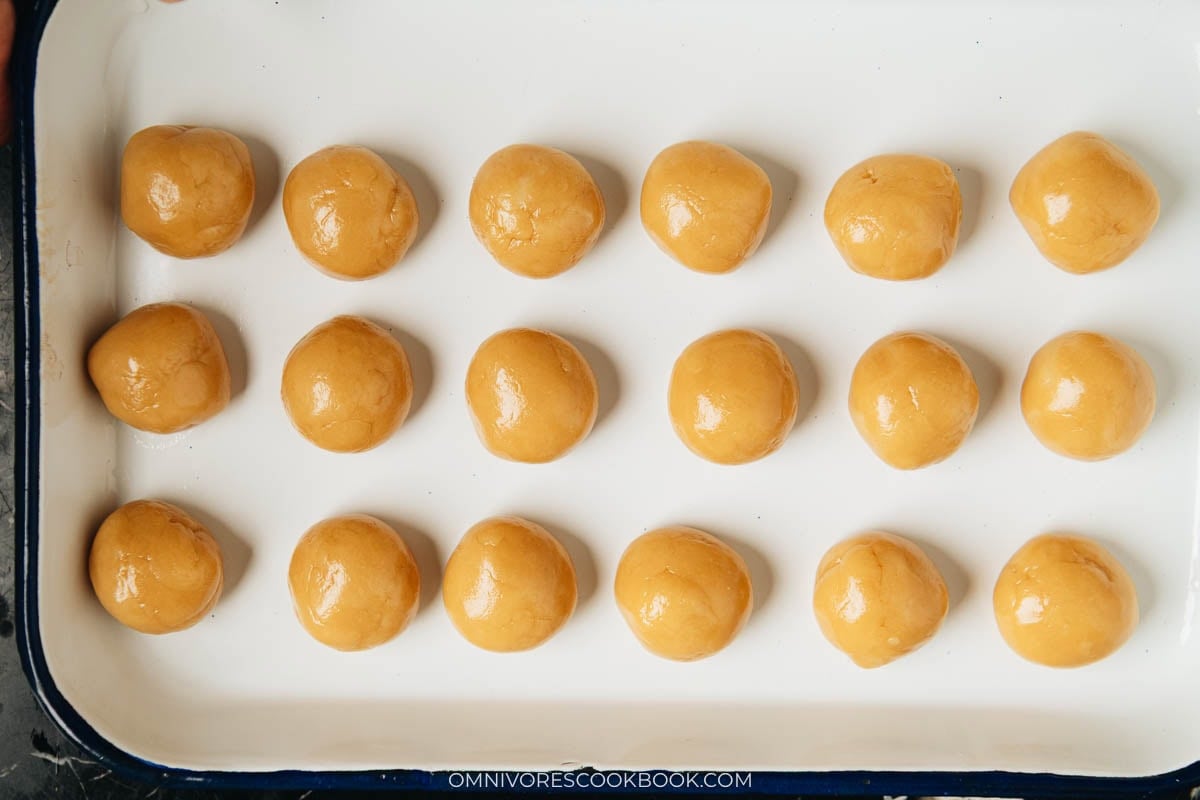
- Once wrapped, dust the dough surface with a thin layer of flour. Place the dough ball into the mooncake mold. Then press the mold to shape the pattern. This step might require a little trial and error. You want to press quite hard, until there’s no room to move. If you notice dough starting to seep out from the mold, you’re pressing too hard. Once you’ve pressed down, you want to hold and press the mold for at least 5 seconds. This is key to ensure the pattern stamps properly and does not bounce back later.
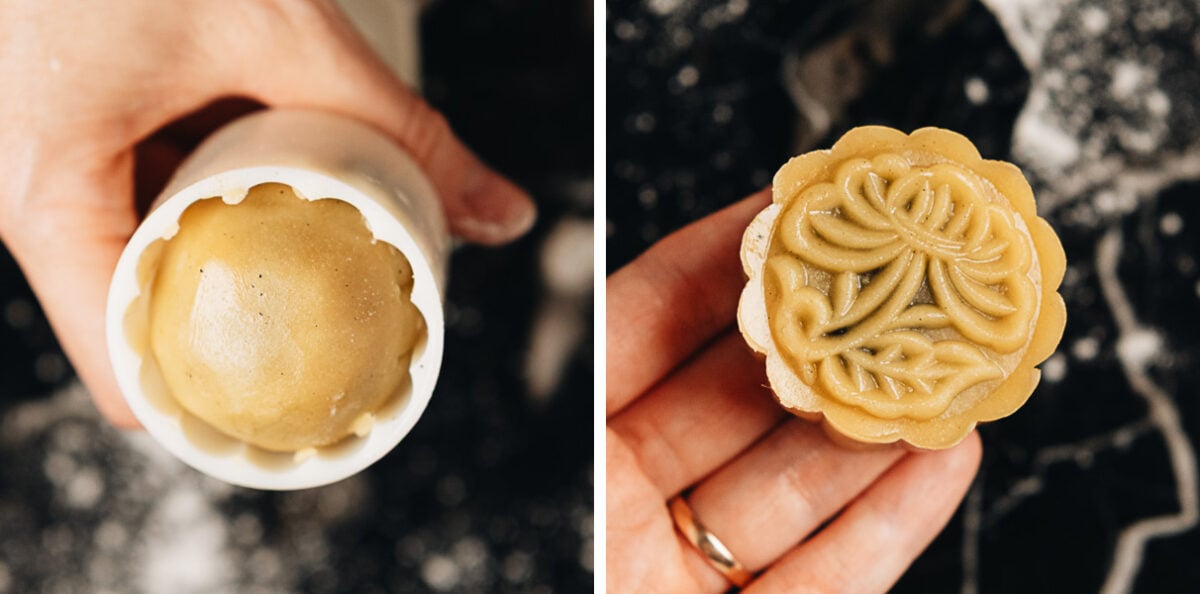
- Place the mooncakes onto a parchment-lined baking sheet. Once the patterns are stamped, you want to bake them as soon as possible to prevent the dough from drying out. If you’re working very slowly, you will need to cover the shaped mooncake with plastic wrap. But be careful not to press the wrap onto the mooncake, which might mess up the pattern.
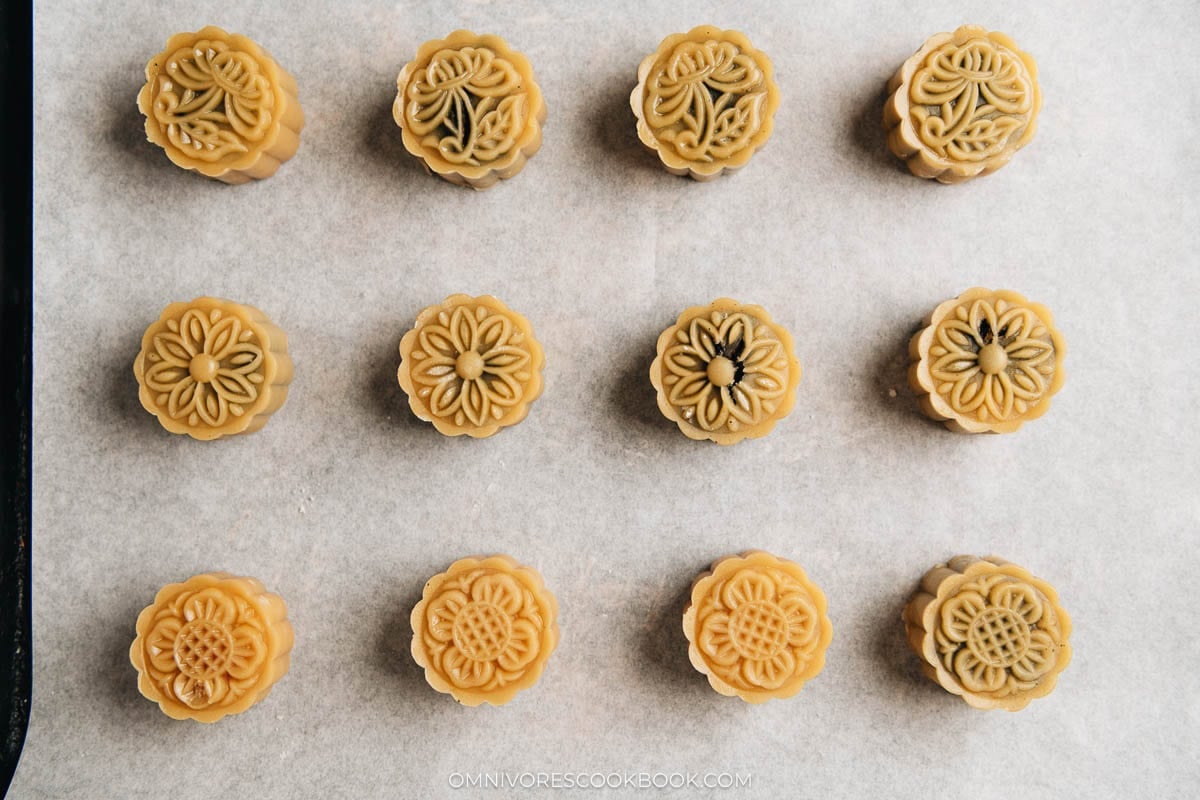
Bake the mooncakes
- Bake at 400°F (200°C) for 5 minutes, so the dough is firm enough for the egg wash. Brush a very thin layer of egg wash onto the arched patterns and try to avoid the caved area. So only the arched area will become darker, giving the mooncake a more three-dimensional look.
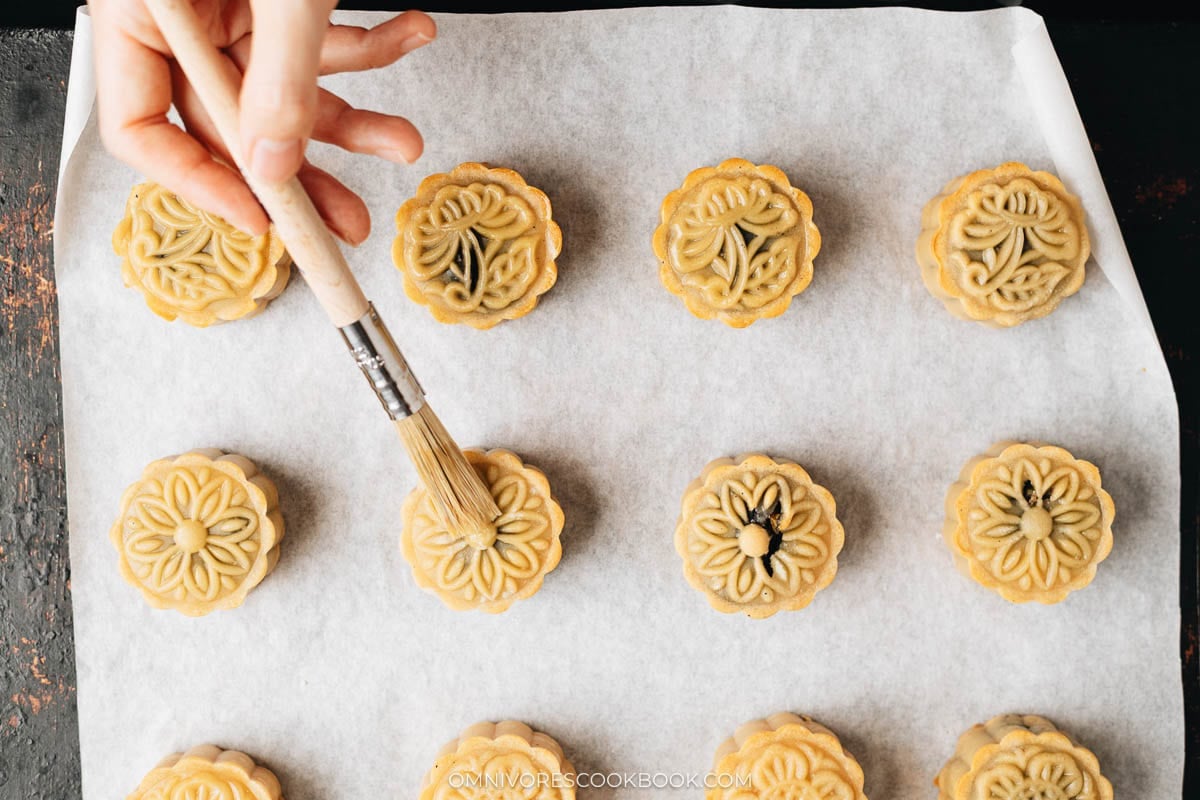
- Lower the oven temperature to 350°F (176°C) and bake for another 12 to 15 minutes, until the mooncakes turn golden brown. Once baked, the mooncakes will look a little dry and the colors uneven. But rest assured, they will look shinier and more even once rested for a day or two.
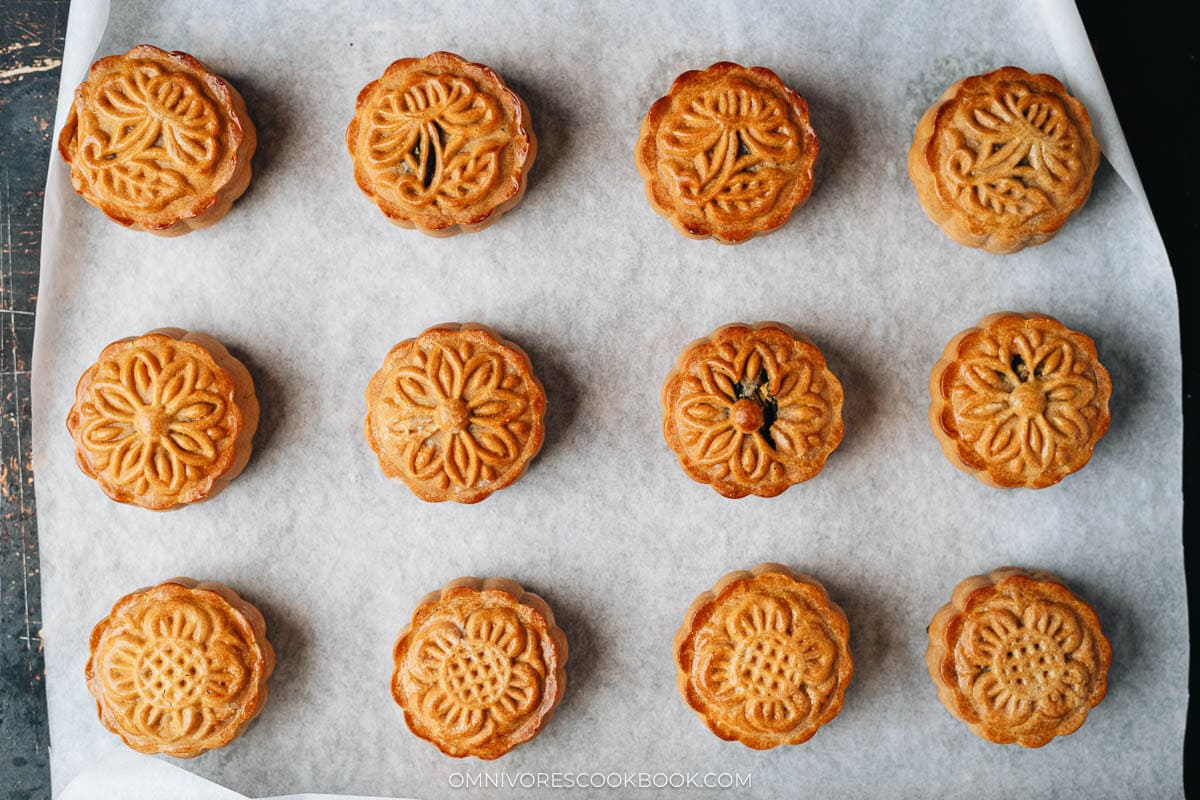
Why is resting mooncakes important?
Resting mooncakes after baking is one of the most important steps for achieving the right taste and texture. This process is called “回油” (huí yóu, “returning oil”), which means to wait for the oil to come out.
Freshly baked mooncakes have a dry, crumbly, and almost cookie-like crust. Resting allows the oil in the dough to migrate outward and the moisture from the filling to move inward, softening the skin into the signature tender, shiny layer. Over a few days, the skin darkens and becomes more golden and glossy, giving the mooncakes a professional look.
The rest period helps the filling and skin meld together. Sweetness, saltiness (from the salted yolk, if used), and aroma become more harmonious, rather than tasting separate.
Typically, Cantonese mooncakes need 2 to 3 days of resting before they’re ready to enjoy at their best. But they usually start to look and taste much better after resting overnight. I always taste them the next day, because I have no patience to wait two days 🙂
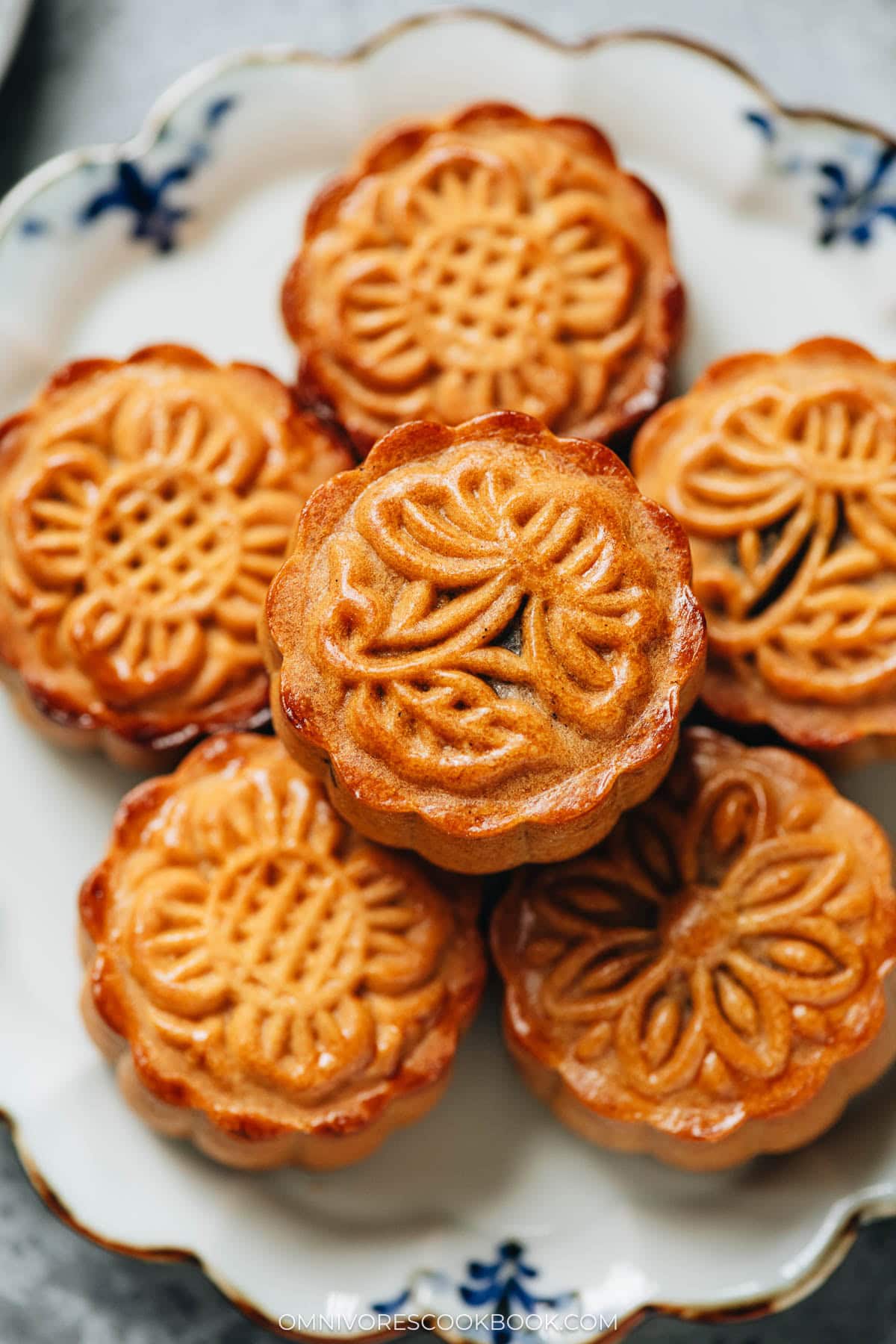
Cooking tips
A scale is the key to success
Making mooncakes requires precision. For the right texture, you will need the correct ratio of flour to golden syrup to kansui. You want to measure the filling quantity so the mooncake has an appropriate proportion of dough to filling. Volumetric measurement and eyeballing simply will not cut it for this recipe.
Be flexible on temperature and baking time
Different ovens will vary in their temperature consistency. I’ve baked mooncakes at 400°F (200°C) and 350°F (176°C), both with good results. I found it best to bake first at a higher temperature for the dough to set, so I can brush the egg wash on easily. Then reduce to a lower temperature to bake evenly and further develop the color. Keep an eye on the mooncakes while baking. If the mooncakes start to develop color too quickly, you might want to reduce the baking time. If the mooncake does not develop color towards the end of cooking, consider raising the temperature back to 400°F (200°C).
Serving and storage
Let the mooncakes rest for 24 to 72 hours after baking. Flavor and texture improve with time.
Store in an airtight container at room temperature if possible, and eat them within a week. Refrigeration can alter their texture.
If freezing, wrap them well and store them in the freezer for up to two months. Thaw them in the fridge slowly, and let the mooncakes return to room temperature before serving.
Frequently asked questions
Do I need to cook the salted egg yolks separately first?
If the salted duck egg yolks you bought are the cooked type, then you don’t need to cook them first. If using raw yolks, you will need to bake them at 350°F (176°C) for 8 to 10 minutes to cook them through before using. Some recipes suggest baking cooked yolks to get rid of the gaminess, but I found that unnecessary.
Can I make the black sesame paste filling in advance and freeze it?
Yes you can! It’s best to freeze the sesame filling after you shape it into balls. So you can directly wrap the mooncakes without thawing the filling. It works beautifully because frozen filling is much easier to work with. If the sesame filling is very frozen (unlike the 30-minute freeze in this recipe), you might want the assembled mooncakes to thaw a little bit before putting them into the mold and shaping them.
Why did my mooncakes crack during baking?
It’s a common practice to spray water onto the mooncakes before baking, to prevent them from cracking. Cracking happens when the dough is not elastic enough. It might happen if you don’t use enough liquid, the flour contains too much gluten, or if the mooncakes are left out too long before baking. Another cause can be because the filling is too wet – especially if you try to make the filling with other ingredients such as sweet potato.
Can I use another type of oil instead of vegetable oil?
Peanut oil works well because it adds nuttiness that works with black sesame filling. Other neutral oil such as sunflower oil will work too.
Can I make mooncakes with chicken eggs?
Yes you can! You can cure chicken egg yolks with salt and sugar. Once cured, the yolks will solidify and can be used in this recipe. Chicken egg yolks are also smaller, so you might be able to fit one yolk into a mooncake instead of halving it, if the yolk is under 10 grams.
Do I have to wait 24 hours to eat these? Or is it possible to eat them straight away?
You can eat them straight away, but you might be disappointed with the texture. The mooncake skin will be rather tough and crumbly, and a little dry. Just so you know, I always taste one straight away because I can’t wait. But the mooncakes start to taste noticeably better on the third day.
Final thoughts
Traditional Cantonese mooncakes are exquisite when done right, not just for their ornate appearance, but also for the harmony of sweet, salty and savory umami. It will take a little practice and patience to make them nicely, but the result is definitely rewarding. Even with boxes of them for sale everywhere this season, homemade mooncakes offer qualities often lost in commercial production. You can taste the freshness of the ingredients and notice a much better depth of flavor. I also like homemade mooncakes because they are less sweet and not as heavy as the commercial type. Lastly, an edible gift made with your own hands is always more special.
If you’re interested in learning about other types of mooncakes, check out my Snow Skin Mooncake with Custard Filling and Pastry Mooncake with Salty Egg Yolk.
Happy Mid-Autumn Festival and I hope you enjoy these homemade mooncakes!
Chinese Cooking Made Easy
Are you new to this website? This free email series is a great place to start. I’ll walk you through a few of my most popular recipes and show you how and why they work. You’ll quickly start to cook better Chinese food in your own kitchen.
Watch video
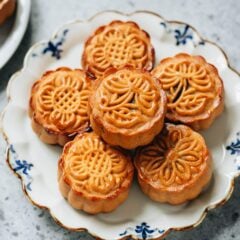
Traditional Mooncake (传统广式月饼)
Ingredients
Mooncake filling
- 140 g (1 1/3 cups) black sesame seeds , toasted
- 80 g (2/3 cup) fine white sugar
- 60 g (4 tablespoons) butter
- 150 g (1 cup) white beans , well drained
- 1 tablespoon maltose (Optional)
- 9 salted duck egg yolks , halved (*footnote 1)
Mooncake dough
- 140 g golden syrup
- 4 g (3/8 teaspoon) kansui
- 50 g vegetable oil
- 1/8 teaspoon salt
- 200 g cake flour
Egg wash
- 1 egg yolk
- 1 teaspoons milk (or water)
Equipment
- 50g mooncake mold
- Scale (*Footnote 2)
- Pastry brush
Instructions
To make mooncake filling
- Add the black sesame seeds into a food processor. Blend until the sesame seeds start to seep oil and thicken, about 2 minutes. Use a spatula to thoroughly scrape the paste from the walls and bottom of the food processor. Blend again until it forms a fine paste, 1 to 2 minutes. Scrape the paste from the walls and bottom.
- Add sugar and white beans. Blend again until everything is fully mixed. If the paste is too thick to blend, you can add a very small amount of water. Transfer the paste to a bowl.
- Heat half of the butter in a medium-sized skillet over medium heat until melted. Add the bean paste. Cook and stir until the butter is fully absorbed. Add the rest of the butter and cook until fully absorbed. Add the maltose if using. Cook and stir until the paste becomes quite dry and able to hold its own shape, 3 to 4 minutes. Transfer the sesame paste to a plate and spread it out. Let cool completely. You can store the sesame paste in the fridge to make it easier to handle later.
To make mooncake dough
- Combine golden syrup, kansui, vegetable oil and salt in a large bowl. Mix with a spatula until emulsified.
- Add cake flour into the bowl. Gently fold the dough with a motion of scraping from bottom to top, like you are folding a cake dough. Do not stir the dough in a circular motion. It will toughen the dough.
- When the flour is fully combined, shape the dough into a ball with your hands. The dough should be soft and a bit sticky but still hold its shape. Seal with plastic wrap. Let rest for 2 hours.
Measure the mooncake filling and dough
- Once it has cooled off, divide the sesame paste into 30-gram portions if not using duck egg yolks. Or add half a duck egg yolk and some sesame paste onto a scale, so that it weighs 30 grams in total. Shape the sesame paste into a ball, then press the center to form a disk. Place the egg yolk in the center. Wrap the sesame paste around the yolk until fully covered, then shape it into a small ball. Place it onto a tray,
- Once you have shaped all the mooncake fillings, cover them with plastic wrap and place them in the freezer. Wait until the balls harden so they’re easier to handle, 30 minutes or so. (*Footnote 3)
- Once the mooncake dough is rested, scoop and measure 20g dough pieces. Shape each dough piece into a ball using your hands. Then place them onto a large tray. Cover the tray with plastic wrap to prevent the dough from drying out.
To assemble mooncakes
- Preheat oven to 400°F (200°C). Line a baking sheet with parchment.
- Place a dough piece onto your palm and use your thumb to flatten the dough from the center, until it forms a round disk that is thinner in the center and thicker on the outside. Place the black sesame filling in the center. Carefully wrap the dough around the filling. Spread the dough until it seals the filling in completely. The dough should be very soft but not sticky, and easy to shape, like soft clay. (*Footnote 4) If you find the dough too thick in some spots, pull off the dough and smooth the surface. It doesn’t matter if the dough is so thin that it reveals the color of the filling. Roll the dough between your hands until the dough forms a smooth ball.
- Slide the plastic pattern disc into the mooncake mold, pattern side down. Twist the handle to lock the pattern disc so it’s secure.
- Dust both hands and the mooncake dough with a bit of cake flour, so it’s easy to release from the mold. Carefully place the mooncake into the mold.
- Place the mold on a clean working surface and firmly press the handle until you cannot move it any further. Hold the handle down for at least 5 seconds so the pattern sticks. Then release the mold from the table and push the handle to release the mooncake onto the lined baking sheet. Work on the rest of the mooncakes and place them onto the tray, about 1” (1.5 cm) apart. Spray a very small amount of water onto the mooncakes to prevent the dough from cracking. Bake for 5 minutes until the patterns are set. The edges of the mooncakes should turn pale golden.
- Meanwhile, make the egg wash by beating the egg yolk with milk (or water) in a small bowl.
- Remove the mooncakes from the oven. Brush a thin layer of egg wash onto the surface of the mooncakes. Only brush the top surfaces, not the vertical (side) surfaces. Try to only brush it onto the arched pattern, and not the recessed concave area. If you accidentally brush too much egg wash and it fills in the pattern, use a small brush to clean the gaps and remove the excess egg wash.
- Place the mooncakes back in the oven and lower the oven temperature to 350°F (176°C). Continue baking until the egg wash turns golden brown, 12 to 15 minutes.
- Let mooncakes cool on the tray for 20 minutes before removing (*footnote 5). Then transfer to a plate to cool completely.
- Once cooled completely, store the mooncakes in an airtight container. The mooncakes can be served after 24 hours, and they will look and taste better after 2 days. (Footnote 6)
Store
- Store the mooncakes in an airtight container in a cool dark area for up to 1 week, or in the fridge for 2 to 3 weeks, or in the freezer for up to 2 months. If stored in the fridge, let the mooncakes return to room temperature before serving. Thaw frozen mooncakes in the fridge overnight before serving.
Notes
- To make black sesame mooncakes without egg yolk, double the black sesame filling and you will be able to make 18 mini mooncakes.
- Mooncake making requires precision and you have to use a food scale to measure the ingredients. Using volumetric measurement won’t be accurate enough and your mooncakes might not come out nicely if you go by volume.
- Sesame filling is not as sticky as other mooncake fillings, such as lotus seed and red bean paste. That’s why I prefer to chill the filling in the freezer before wrapping, so the filling hardens up.
- If your dough turns out too tough to shape with your hands (usually happens if you use all-purpose flour, which contains more gluten and makes a tougher dough), you can do this instead: Place the dough between two pieces of parchment. Press it into a flat disc. Roll it into a small round sheet. It should be fairly easy to wrap the dough using the dough sheet. If the dough sheet breaks off, you can easily patch it onto the filling until the filling is fully covered.
- The mooncakes will be flaky and soft when hot. If you remove them right after baking, the cakes will crush easily.
- The process is called 回油 (Hui You), a process whereby the oil from the filling releases into the dough, making the mooncake dough softer. The mooncake will look a little dry immediately after baking, but will look moist and tender after a day or two. The patterns will also have a rounder, nicer look.
Nutrition

Did you make this recipe?
I’d love to hear how it turned out for you! Please take a moment to leave a 5-star rating ⭐️ and share your thoughts in the comments further down the page. It really helps others discover the recipe too.
This recipe was originally published in September 2015 and was updated in September 2025 (wow it has been 10 years!). In the updated version, I did a few things differently:
- I used commercial golden syrup and kansui instead of the homemade type. Compared to 10 years ago, both ingredients are more available and it’s easy to purchase them online. I recommend using the commercial type instead of homemade, if possible. Because the acid level in the syrup and alkaline level in the lye water are not precise when you make them at home. Using the homemade versions might result in cracked mooncake dough.
- Instead of using glutinous rice flour, I used white beans in the filling as a binder. The beans improve the mooncake texture and make it smoother.
- The new recipe has a slightly improved dough texture that is easier to work with.
- I updated the shaping method and baking temperature, so the mooncakes look better.

Betsy
Maggie, this recipe is astonishing, and so very kind to the cook who has never seen a moon-cake, let alone made one! I will give it a try and I think it will become a favorite addition to my baking repertoire. Thank you so much for leading me on this adventure, and Happy Mid- Autumn.
lean ong
Hi Maggie ,
Please help to advise if I can use your sesame filling recipe in snowskin mooncake please, do I need to cook the filling ? Or should I use other flour ?
Making the moo cake tomorrow, my family is pure cantonese and love this filling lots. Outside ready-made filling is too sweet
Pamela
Enjoyed reading your cooking experience with the moon cakes, very informative, thorough and learned a lot. Also, patient.
Thank you for the great recipes.
Welly
Hi.. i tried your mooncake recipe… But i was using mug bean instead. The problem was the skin dough… It’s crumbly….
The skin tear and broken before i put it in the mould. And it can’t be fixed as the skin dough isn’t that elastic..
May be you could help me to figure it out… Thank you
lean ong
Hi Maggie,
This is my first time doing mooncake for my family. would like to use your black sesame filling for my snowkin mooncake.
How shld I cook my filling ? Do I still use glutinous rice flour.
Please help, my family loves black sesame
Amarie
Maggie,
It’s probably too late this year but you know, it’s a great business idea if you offer to ship prepacked ingredients to those who want to make it. Like a whole mooncake making kit 🙂 I’d love to make it but acquiring all these ingredients will be too much of a hassle! I imagine there are a lot out there who feel the same way. It’s hard to find Asian stores that actually stock these ingredients, I haven’t even found a mould the whole time I have been here. Nevertheless, I have yet to look online 😉
Personally, I love the non bake mooncake, I find it refreshing and it reminds me of my childhood. Maybe that could be your next venture!
Kathrine
Thank you so much. I’m so glad I found this post. Mooncakes are an arm and a leg where I live and my last few attempts have been delicious but messy.
Lilis
the recipe for the syrup,
50 milliliters fresh lemon juice, strained (from 1 big lemon)
400 grams (200 milliliters) caster sugar
200 milliliters filtered water, and more to brush on the pot
when the syrup ready with this recipe, what is the weight? or do you use them all?
Maggie
Hi Lilis, I’m afraid I don’t have the weight of the final product. I used a thermometer to measure the temperature to determine whether the syrup is ready.
Sunny
For the egg wash, do you think it might be simpler to brush it on before molding the dough? Just a thought.
Vera
I am sooo… going to use your recipe to try making mooncakes! Your post is so thorough and detailed. Thanks for your generosity to share your knowledge and experience.
Mandie
I had a suggestion, from banggood, to buy moon cake molds. I had never thought of making them before, but have recently taken to cake/cupcake baking and decorating, so I thought I’d look up moon cakes as my husband’s family are from China and it might be a nice treat to have home made moon cakes this year since none of them have been home in about 50 years. I read a few recipes before I found yours, and I don’t think I’ll be looking any further, unless I decide to try a different filling (I haven’t yet checked to see if you’ve added a different filling recipe). You can tell how much time and passions you put into this. Your write up was an amazing and informative read, I would have loved to have read the longer version! I will be bookmarking this and attempting it this year. Thank you for the time and effort you put into this.
I do have one question though. Do I need to use duck egg? or can it be chicken egg?
Thanks.
Maggie
Hi Mandie, thanks so much for your kind words and I’m glad to hear you decide to try out making mooncake this year!
To answer your question, you can use salted chicken egg yolk as well. You can find these packaged one in Asian market. Let me know if you can’t find them. I’d love to share a salted egg yolk recipe on my blog!
I haven’t developed other filling yet. This year I might try to make a lotus seed filling, or red bean paste filling. I’ll make sure to add these links when I develop new filling recipes.
Happy cooking Mandie, and let me know how your mooncakes turn out! 🙂
HELEN
Hi Maggie,
I am going to attempt these however can you clarify the centre of the cakes? Do you just add salt to the yolk? I can see in the photos it looks almost like dough but I am confused as to how it’s made.
I am off to the Chinese supermarket tomorrow so want to get all the ingredients and spend my afternoon making these cakes!
They look amazing! Thank you for the recipe!
Maggie
Hi Helen, I bought these the salty egg yolk in the Asian market. You need to cure them if making from scratch, so I would recommend you to purchase them directly.
The filling is made with a few solid ingredients (such as the sesame paste and flour) so it has a dough like texture when you mix everything together.
Let me know if you have more questions! Happy cooking and hope your mooncakes turn out well 🙂
Elisabeth
Any idea why the crust/skin might turn out great the first day but quickly become slimy later? Too much oil? Timing of the egg wash?
Maggie
Hi Elisabeth, the problem is definitely not caused by egg wash. In fact, the mooncake skin is supposed to be tender and not crispy. If you like a crispy texture, then you might find it taste better immediately after baking. If the texture is sticky (slimy), my suspect is too much oil.
Atisha
Beautiful work maggie!
I tried making them and they are just wonderful!
Tried making the black sesame paste too but is it usual to tase slightly bitter?
Maggie
Hi Atisha, I’m glad your mooncakes turn out great! If your black sesame paste taste slightly bitter, you might have roasted the sesame seeds a bit too long. Hope it doesn’t affect the taste of the mooncakes too much.
Have a great week ahead 🙂
Michelle
Thank you for an awesome and thorough recipe! Being armed with so much good info made aking these mooncakes surprisingly approachable. Now that I have some tasty mooncakes on my hands, how long will they keep in an airtight container? Can I freeze them?
colleen
Hello Maggie. I found your blog looking for a beef broth recipe. I liked your style and decided to follow you. I looked around your blog and came across this post. My like turned to sheer admiration for you. To post a 4000+ post in a world of twitter is an act of courage. You did fabulous and the post reads well and easily – great writing skills. Then there is the actual recipe and the testing.
Maggie I would like to bow to you. Beautiful work here. We’ll done. You have proven the value of being a master student.
PS my husband is a trained chef and I am a consummate foodie. I read a LOT of blogs. You really are exceptional.
Maggie
Hi Colleen, thanks so much for your kind words! You just made my day 🙂
I had doubt about my mooncake post once I published it. I thought, who has the time to read it? I was surprised to see there are many readers did find the post helpful and would like to challenge mooncake making at home.
I do super long post once in a while, usually for authentic Chinese recipes that I’m obsessed with. I’m glad that people like you have the patient to read it. And it is always great to know that more people get to know real Chinese food through my blog 🙂
Many many thanks again for the encouraging words! Have a great week ahead Colleen 🙂
Kristen Majocha
This week I made my first moon cakes for my Chinese students. It took me several days, many substitutions, and a few tears (I loved reading about your similar emotions!). I quick cured my salted yolks and made a bean paste out of need due to a lack of planning. I had no idea how complex this dish was; I have never had s moon cake! I will try a moon cake (my own) for the first time tomorrow. My students will eat them too! I know the filling is not smooth and I had no mold so no patten (large round cakes). But I can’t wait to cut into it and see the moon. And my students were very thankful for the care and time I demonstrated for them. I love your post and instructions. I know I will do better next year!
Maggie
Hi Kristen, making mooncakes are a lot of work aren’t they!? When I finished writing the recipe, I thought, who’s gonna cook this? Luckily I found out many people would like to challenge it in their own kitchen 🙂 It’s amazing that you cured your own salty egg yolks. I need to do that soon. It is very expensive to buy them in supermarket.
I hope your second batch of mooncake came out well! Thanks for leaving a comment to share your experience. It’s really great to know people care about mooncakes. I will keep developing new mooncake recipes for sure!
zj
Absolutely Five Stars!
zj
Hi Maggie,
I really enjoyed your post. It was like reading a story. I had just made 30 mini mooncakes myself this morning before I landed in your blog. I wish I found your instructions earlier. I did make a few mistakes that you pointed out in your post. If I have time before August 15th this year I would certainly try your recipe out. I also love black sesame seeds. I combined them with lotus seed paste that I made from scratch. I will bookmark your site and check back often.
Thank you for your good work on putting together such detailed instructions. So helpful yet enjoyable.
Maggie
So glad to hear you find the post helpful! I love the idea of adding black sesame seeds into lotus seed paste. Sounds yummy!
Happy Mid-autumn Festival 🙂
Emily
Hi Maggie,
Thank you for the super helpful and detailed post! I’m following your recipe to make homemade mooncakes for the first time. My black sesame filling is coming out dry and crumbly. I can’t seem to shape it into a ball and flattening it without it falling into pieces. Do you have any tips on fixing that?
Maggie
Hi Emily, I’m sorry to hear that your mooncake filling didn’t turn out well. Two factors might cause dry filling (1) you didn’t ground the sesame seeds long enough to release more oil (2) you need more fat content to bind everything together. I suggest you to return the filling back in the food process and mix it again. Let it run for 1 to 2 minutes, and see whether the filling turns tender and possible to shape. If not, add a bit more butter (1/2 tablespoon) at a time and keep mixing. Stop in betweens and pinch some filling with your fingers and see whether it forms a dough texture.
Hope you could fix the mooncake filling and the mooncakes turn out well.
whing
Hi Maggie, I love this recipe and use it every year, but probably didn’t make any last year. I tried experimenting with white sesame and food colouring to make rainbow mooncakes which looked like parrots when cut up! Also, I used a peanut filling before which people loved. I tried to modify the outside skin with a thin layer of royal icing to make ‘pretend’ snow skin mooncakes which I didn’t need to bake. I’ve made so many modifications over time, I’ve decided, this year to go back to the traditional moon cake. I just wanted to find out how long they last, as having a party in a week’s time. All the best and thank you for your wonderful recipe and all the hints and tips.